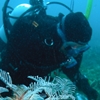General Description
Colony of individual polyps (hydranths) joined by root-like network of tubular stolons at the base. Colony shape is feather-like (pinnate). Colour: pale greyish. Up to 5 cm high.
Biology
This is one of the most spectacular and graceful hydroids in southern Australia. They are rarely seen because they often attach to the underside of ledges. Their colonies grow late summer to winter, and become fertile in winter.
Habitat
Deep water reef, often under ledges.
Reefs
Distribution guide
Southern Australia.
Species Group
Depth
Shallow (1-30 m)
Deep ( > 30 m)
Water Column
Max Size
5 cm
Diet
Plankton or Particles
Harmful
Generally not harmful but still able to sting bare skin.
Commercial Species
No
Identify
Conservation Status
- DSE Advisory List : Not listed
- EPBC Act 1999 : Not listed
- IUCN Red List : Not listed





